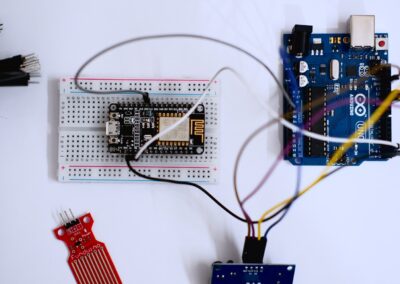Preventing Device Bricking with Robust Failsafe Mechanisms
Understanding the Importance of Failsafe Mechanisms in IoT Firmware Updates
Implementing a failsafe mechanism in IoT firmware updates is crucial for preventing device bricking and ensuring the reliability of IoT systems. Firmware updates are essential for maintaining device security, adding new features, and fixing bugs. However, the update process can be risky. If an update fails, it can render a device unusable—a condition known as “bricking.” This is particularly concerning in critical applications, such as smart cities in Riyadh or healthcare systems in Dubai, where device functionality is paramount. A failsafe mechanism acts as a protective measure that ensures devices can revert to a previous stable state if an update fails, thus preventing downtime and potential disruptions in service.
Strategies for Implementing Failsafe Firmware Updates
To implement failsafe firmware updates effectively, several strategies can be employed. One common approach is the dual-bank or dual-partition strategy. This involves maintaining two separate firmware copies on the device: the current version and the new version being updated. During the update process, the new firmware is written to the inactive partition. Once the update is complete and verified, the device switches to the new partition. If any issues are detected, the device can revert to the previous version seamlessly. This method ensures continuous operation even if the new firmware update encounters problems.
Another strategy is using atomic updates, where the update process is treated as an all-or-nothing operation. This ensures that the new firmware is fully written and verified before it is activated. If the update process is interrupted, the device retains the old firmware, avoiding partial updates that could lead to bricking. Additionally, incorporating a watchdog timer can help monitor the update process and trigger a rollback if the device becomes unresponsive for an extended period.
Case Studies: Successful Implementation of Failsafe Mechanisms
Numerous case studies highlight the effectiveness of failsafe mechanisms in preventing device bricking. For instance, in the UAE’s smart transportation networks, IoT devices such as traffic lights and surveillance cameras are crucial for managing city infrastructure. Implementing a failsafe mechanism in these devices ensures that they continue to operate reliably even during firmware updates. Similarly, in Saudi Arabia’s energy sector, smart meters and grid management systems benefit from failsafe updates, ensuring uninterrupted energy distribution and monitoring.
One notable example is the use of failsafe mechanisms in medical devices within Dubai’s healthcare systems. Medical IoT devices require high reliability, and any malfunction can have severe consequences. By implementing dual-bank updates and watchdog timers, these devices can receive necessary updates without risking patient safety. These examples demonstrate the critical role of failsafe mechanisms in maintaining device integrity and operational continuity.
Enhancing IoT Security with Advanced Firmware Update Strategies
Integrating Blockchain for Secure Firmware Updates
Integrating blockchain technology into the firmware update process can further enhance security and reliability. Blockchain provides a decentralized and tamper-proof ledger for recording firmware updates, ensuring that only authorized updates are applied to IoT devices. This approach can prevent malicious firmware from being installed, as each update is verified against the blockchain ledger before deployment.
In Saudi Arabia and the UAE, where cybersecurity is a priority, blockchain integration can safeguard critical IoT infrastructure. For example, in Riyadh’s smart grid projects, blockchain can ensure that only verified firmware updates are applied to smart meters and grid controllers, protecting the integrity of the energy distribution network. Similarly, in Dubai’s financial sector, blockchain can secure IoT devices used for payment processing and transaction verification, preventing unauthorized modifications that could lead to financial fraud.
Leveraging Artificial Intelligence for Predictive Maintenance and Updates
Artificial Intelligence (AI) can be leveraged to enhance the firmware update process by predicting potential issues and optimizing update schedules. AI algorithms can analyze device performance data to identify patterns that may indicate the need for a firmware update. By scheduling updates during periods of low activity or predicted maintenance windows, AI can minimize the impact on device availability and ensure a smooth update process.
In Saudi Arabia’s industrial sector, AI-driven predictive maintenance can optimize the timing of firmware updates for IoT devices used in manufacturing and logistics. This approach ensures that updates are applied without disrupting production schedules. In the UAE’s healthcare systems, AI can help schedule updates for medical IoT devices during planned maintenance periods, ensuring that critical medical equipment remains operational when needed most.
Executive Coaching and Leadership in Implementing Secure Firmware Update Strategies
Executive coaching services can play a vital role in guiding organizations through the implementation of secure firmware update strategies. Effective leadership is essential for fostering a culture of security and ensuring that best practices are followed throughout the organization. Executive coaches can help leaders understand the importance of failsafe mechanisms, blockchain integration, and AI-driven predictive maintenance, empowering them to make informed decisions and allocate resources effectively.
In Riyadh and Dubai, where technological innovation is a key focus, executive coaching can support leaders in developing and implementing robust firmware update strategies. By fostering collaboration between IT teams, cybersecurity experts, and business leaders, organizations can create a cohesive approach to IoT security that protects critical infrastructure and enhances overall operational resilience.
Conclusion
Implementing a failsafe mechanism in IoT firmware updates is crucial for preventing device bricking and ensuring the reliability of IoT systems. By adopting strategies such as dual-bank updates, atomic updates, and watchdog timers, organizations can safeguard their IoT devices against update failures. Integrating advanced technologies such as blockchain and AI further enhances the security and efficiency of the firmware update process. Executive coaching services can support leaders in driving these initiatives, fostering a culture of security and innovation. As IoT adoption continues to grow in Saudi Arabia and the UAE, robust firmware update strategies will be essential for maintaining the integrity and reliability of critical infrastructure.
—
#FailsafeMechanism #IoTFirmwareUpdates #DeviceBrickingPrevention #IoTSecurity #FirmwareUpdateStrategies #SaudiArabiaTech #UAETech #ArtificialIntelligence #Blockchain #ModernTechnology #BusinessSuccess































